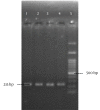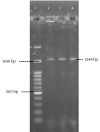Prevalence of Virulence-Related Determinants in Clinical Isolates of Staphylococcus epidermidis
- PMID: 27800129
- PMCID: PMC5078722
- DOI: 10.5812/jjm.30593
Prevalence of Virulence-Related Determinants in Clinical Isolates of Staphylococcus epidermidis
Abstract
Background: Staphylococcus epidermidis, a member of the human flora, is recognized as an opportunistic pathogen and cause of nosocomial infections. Staphylococcus epidermidis surface components are able to establish bacteria on the host surface, and cause infection.
Objectives: The frequency of icaA, IS256, aap, fbe and bhp in clinical isolates of S. epidermidis were investigated in this study.
Materials and methods: Fifty-nine S. epidermidis isolates were collected from blood (50), wound (1), urine (4) and tracheal (4) samples (Tehran, Iran). Staphylococcus epidermidis isolates were identified with conventional bacteriological tests. Virulence-associated genes were detected by specific polymerase chain reactions (PCRs).
Results: Of the 59 S. epidermidis, fbe was found in 89.8%, while aap and bhp were observed in 64.4% and 15.3% of the samples, respectively. Coexistence of aap and fbe was found in 32 isolates, while coexistence of bhp and fbe was observed in five isolates. Two isolates were negative for the investigated genes.
Conclusions: Prevalence of fbe and aap was significantly different from similar studies, yet frequency of bhp was in accordance with other studies. Prevalence of icaA and IS256 was not significantly different from some studies while a significant difference was observed when results were compared with some other studies.
Keywords: Staphylococcal Infections; Staphylococcus epidermidis; Virulence Factors.
Figures





Similar articles
-
Antimicrobial susceptibility, virulence determinants profiles and molecular characteristics of Staphylococcus epidermidis isolates in Wenzhou, eastern China.BMC Microbiol. 2019 Jul 9;19(1):157. doi: 10.1186/s12866-019-1523-6. BMC Microbiol. 2019. PMID: 31288755 Free PMC article.
-
Prevalence of virulence determinants in Staphylococcus epidermidis from ICU patients in Kampala, Uganda.J Infect Dev Ctries. 2012 Mar 12;6(3):242-50. doi: 10.3855/jidc.2007. J Infect Dev Ctries. 2012. PMID: 22421605
-
Detection of virulence-associated genes not useful for discriminating between invasive and commensal Staphylococcus epidermidis strains from a bone marrow transplant unit.J Clin Microbiol. 2004 Dec;42(12):5614-9. doi: 10.1128/JCM.42.12.5614-5619.2004. J Clin Microbiol. 2004. PMID: 15583290 Free PMC article.
-
Strong biofilm production but not adhesion virulence factors can discriminate between invasive and commensal Staphylococcus epidermidis strains.APMIS. 2012 Aug;120(8):605-11. doi: 10.1111/j.1600-0463.2012.02877.x. Epub 2012 Mar 5. APMIS. 2012. PMID: 22779682
-
Success through diversity - how Staphylococcus epidermidis establishes as a nosocomial pathogen.Int J Med Microbiol. 2010 Aug;300(6):380-6. doi: 10.1016/j.ijmm.2010.04.011. Epub 2010 May 6. Int J Med Microbiol. 2010. PMID: 20451447 Review.
Cited by
-
Treatment Strategies for Infected Wounds.Molecules. 2018 Sep 18;23(9):2392. doi: 10.3390/molecules23092392. Molecules. 2018. PMID: 30231567 Free PMC article. Review.
-
Bacterial colonization, species diversity and antimicrobial susceptibility patterns of indwelling urinary catheters from postpartum mothers attending a Tertiary Hospital in Eastern Uganda.PLoS One. 2022 Jan 10;17(1):e0262414. doi: 10.1371/journal.pone.0262414. eCollection 2022. PLoS One. 2022. PMID: 35007300 Free PMC article.
-
The frequency of adherence, biofilm-associated, Arginine Catabolic Mobile element genes, and biofilm formation in clinical and healthcare worker coagulase-negative staphylococci isolates.BMC Microbiol. 2023 Aug 15;23(1):222. doi: 10.1186/s12866-023-02959-x. BMC Microbiol. 2023. PMID: 37582708 Free PMC article.
-
Staphylococcus epidermidis Pathogenesis: Interplay of icaADBC Operon and MSCRAMMs in Biofilm Formation of Isolates from Pediatric Bacteremia in Peshawar, Pakistan.Medicina (Kaunas). 2022 Oct 24;58(11):1510. doi: 10.3390/medicina58111510. Medicina (Kaunas). 2022. PMID: 36363467 Free PMC article.
References
-
- Costerton JW, Stewart PS, Greenberg EP. Bacterial biofilms: a common cause of persistent infections. Science. 1999;284(5418):1318–22. - PubMed
-
- Davis SL, Gurusiddappa S, McCrea KW, Perkins S, Hook M. SdrG, a fibrinogen-binding bacterial adhesin of the microbial surface components recognizing adhesive matrix molecules subfamily from Staphylococcus epidermidis, targets the thrombin cleavage site in the Bbeta chain. J Biol Chem. 2001;276(30):27799–805. doi: 10.1074/jbc.M103873200. - DOI - PubMed
LinkOut - more resources
Full Text Sources
Other Literature Sources
Miscellaneous
